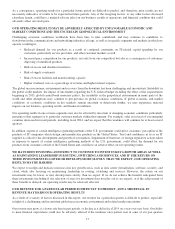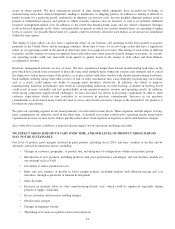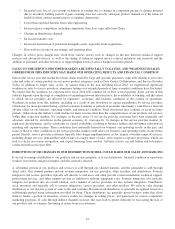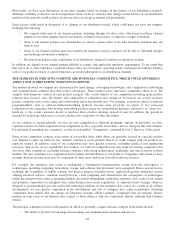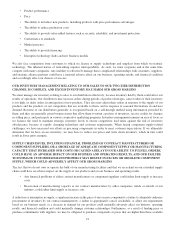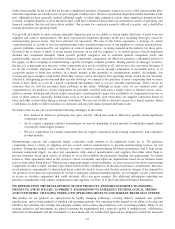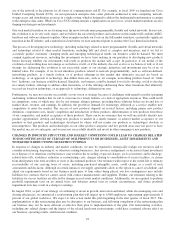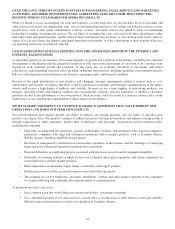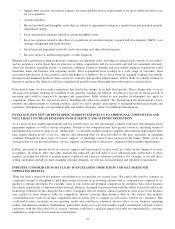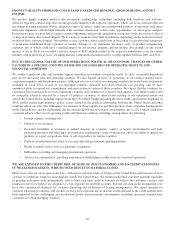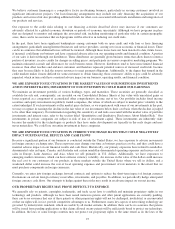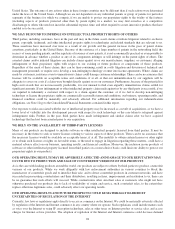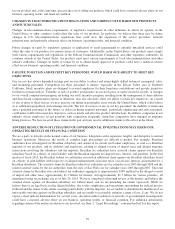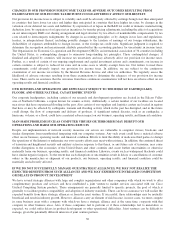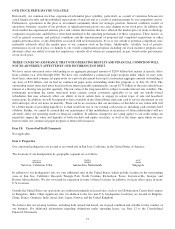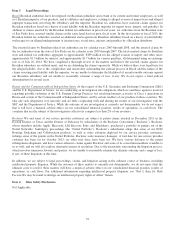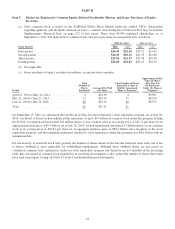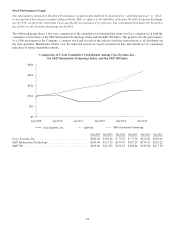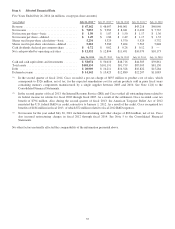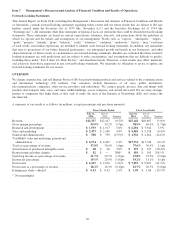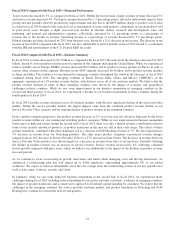Cisco 2014 Annual Report Download - page 35
Download and view the complete annual report
Please find page 35 of the 2014 Cisco annual report below. You can navigate through the pages in the report by either clicking on the pages listed below, or by using the keyword search tool below to find specific information within the annual report.We believe customer financing is a competitive factor in obtaining business, particularly in serving customers involved in
significant infrastructure projects. Our loan financing arrangements may include not only financing the acquisition of our
products and services but also providing additional funds for other costs associated with network installation and integration of
our products and services.
Our exposure to the credit risks relating to our financing activities described above may increase if our customers are
adversely affected by a global economic downturn or periods of economic uncertainty. Although we have programs in place
that are designed to monitor and mitigate the associated risk, including monitoring of particular risks in certain geographic
areas, there can be no assurance that such programs will be effective in reducing our credit risks.
In the past, there have been significant bankruptcies among customers both on open credit and with loan or lease financing
arrangements, particularly among Internet businesses and service providers, causing us to incur economic or financial losses. There
can be no assurance that additional losses will not be incurred. Although these losses have not been material to date, future losses,
if incurred, could harm our business and have a material adverse effect on our operating results and financial condition. A portion
of our sales is derived through our distributors. These distributors are generally given business terms that allow them to return a
portion of inventory, receive credits for changes in selling prices, and participate in various cooperative marketing programs. We
maintain estimated accruals and allowances for such business terms. However, distributors tend to have more limited financial
resources than other resellers and end-user customers and therefore represent potential sources of increased credit risk, because
they may be more likely to lack the reserve resources to meet payment obligations. Additionally, to the degree that turmoil in the
credit markets makes it more difficult for some customers to obtain financing, those customers’ ability to pay could be adversely
impacted, which in turn could have a material adverse impact on our business, operating results, and financial condition.
WE ARE EXPOSED TO FLUCTUATIONS IN THE MARKET VALUES OF OUR PORTFOLIO INVESTMENTS
AND IN INTEREST RATES; IMPAIRMENT OF OUR INVESTMENTS COULD HARM OUR EARNINGS
We maintain an investment portfolio of various holdings, types, and maturities. These securities are generally classified as
available-for-sale and, consequently, are recorded on our Consolidated Balance Sheets at fair value with unrealized gains or
losses reported as a component of accumulated other comprehensive income, net of tax. Our portfolio includes fixed income
securities and equity investments in publicly traded companies, the values of which are subject to market price volatility to the
extent unhedged. If such investments suffer market price declines, as we experienced with some of our investments in the past,
we may recognize in earnings the decline in the fair value of our investments below their cost basis when the decline is judged
to be other than temporary. For information regarding the sensitivity of and risks associated with the market value of portfolio
investments and interest rates, refer to the section titled “Quantitative and Qualitative Disclosures About Market Risk.” Our
investments in private companies are subject to risk of loss of investment capital. These investments are inherently risky
because the markets for the technologies or products they have under development are typically in the early stages and may
never materialize. We could lose our entire investment in these companies.
WE ARE EXPOSED TO FLUCTUATIONS IN CURRENCY EXCHANGE RATES THAT COULD NEGATIVELY
IMPACT OUR FINANCIAL RESULTS AND CASH FLOWS
Because a significant portion of our business is conducted outside the United States, we face exposure to adverse movements
in foreign currency exchange rates. These exposures may change over time as business practices evolve, and they could have a
material adverse impact on our financial results and cash flows. Historically, our primary exposures have related to nondollar-
denominated sales in Japan, Canada, and Australia and certain nondollar-denominated operating expenses and service cost of
sales in Europe, Latin America, and Asia, where we sell primarily in U.S. dollars. Additionally, we have exposures to
emerging market currencies, which can have extreme currency volatility. An increase in the value of the dollar could increase
the real cost to our customers of our products in those markets outside the United States where we sell in dollars, and a
weakened dollar could increase the cost of local operating expenses and procurement of raw materials to the extent that we
must purchase components in foreign currencies.
Currently, we enter into foreign exchange forward contracts and options to reduce the short-term impact of foreign currency
fluctuations on certain foreign currency receivables, investments, and payables. In addition, we periodically hedge anticipated
foreign currency cash flows. Our attempts to hedge against these risks may result in an adverse impact on our net income.
OUR PROPRIETARY RIGHTS MAY PROVE DIFFICULT TO ENFORCE
We generally rely on patents, copyrights, trademarks, and trade secret laws to establish and maintain proprietary rights in our
technology and products. Although we have been issued numerous patents and other patent applications are currently pending,
there can be no assurance that any of these patents or other proprietary rights will not be challenged, invalidated, or circumvented
or that our rights will, in fact, provide competitive advantages to us. Furthermore, many key aspects of networking technology are
governed by industrywide standards, which are usable by all market entrants. In addition, there can be no assurance that patents
will be issued from pending applications or that claims allowed on any patents will be sufficiently broad to protect our technology.
In addition, the laws of some foreign countries may not protect our proprietary rights to the same extent as do the laws of the
27


